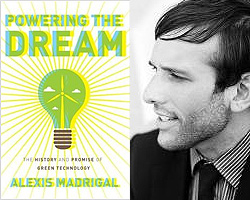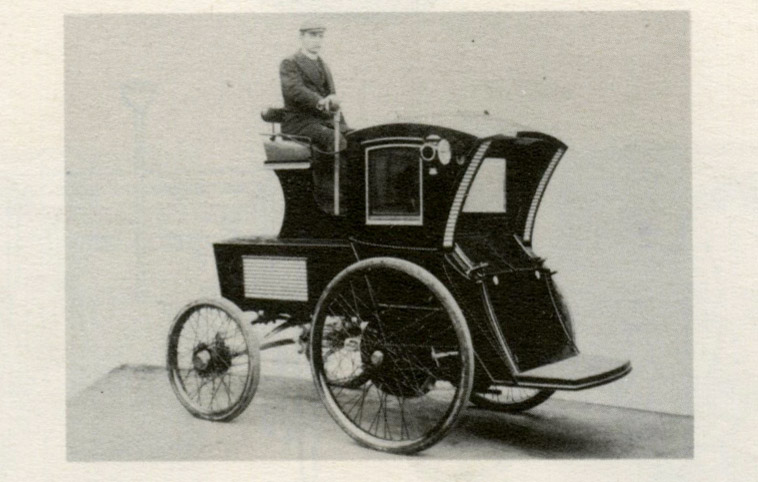 This is the first in a series from my conversation with Atlantic tech channel editor Alexis Madrigal about themes and stories from his new book, Powering the Dream: The History and Promise of Green Technology.
This is the first in a series from my conversation with Atlantic tech channel editor Alexis Madrigal about themes and stories from his new book, Powering the Dream: The History and Promise of Green Technology.
DR: What were the first glimmers of the book?
AM: It was about 2007. At the time, Bruce Sterling had just said, “green will never be sexier than it is right now.” And that was true.
I kept hearing these apocryphal stories about renewable energy projects of the past. The first one I heard about was Luz solar plants out in the Mojave. As someone who had grown up thinking of solar as just photovoltaics, the idea that there was this huge solar power plant in the desert, built during the Reagan administration, was just mind-blowing. Why hasn’t anyone ever told me about this?
I started searching the patent literature and finding old wave motors. The clincher for me was that I found an old book called Power from the Wind, a 1940s account of building the first megawatt-scale wind machine. It was such a cracking good story! It had all these characters, like FDR’s science advisor Vannevar Bush, and this MIT geologist-slash-heir-to-a-publishing-fortune named Palmer Putnam, who went bankrupt. He is more famous for having invented the Duckmobile, which carries frat boys in an amphibious landing vehicle.
DR: We have those in Seattle. Now I know who to blame.
AM: What I decided to do was to go find these people, who seemed to me a forgotten set of ancestors for the current set of climate hawks and green technologists, and just tell their stories. No one had really put it together.
 Out in the Mojave: Luz Industries’ SEGS I and SEGS II solar plants, built in 1984 and 1985.
Out in the Mojave: Luz Industries’ SEGS I and SEGS II solar plants, built in 1984 and 1985.
DR: The characters in your stories, some of them are utopianists and visionaries, but none of them have the anti-growth, anti-capitalist mindset that environmentalism took on in the 70’s. They all seem like … hustlers.
AM: That’s what you find. You find more entrepreneur, innovator types than traditional environmentalists, in the way that we know [environmentalism] from this historically specific period tied in with the growth of ecology and ’60s and ’70s activism.
Even people who might look to the outside observer like dirty hippies, the people around the Whole Earth Catalog, they were more into building new stuff. They weren’t exactly pro-building thousands of power plants across the country, but they weren’t anti-changing the world to more suit human needs.
That’s the key thing I saw: People who have dealt with environmentalism on the land side of things tend to think in terms of conservation — preserving that which exists. If you’re on the energy side of things, it becomes immediately clear that if you want energy for human purposes, you have to take it from the environment one way or another. You have to be more pragmatic than when you’re just buying land and keeping human beings out of it.
DR: You make it clear in the book that the arguments we’re having today have happened before. One I found fascinating was the competition among car technologies at the beginning of the 20th century. The electric guys forecast all the advantages of electric cars — the same benefits we argue for now. They were correct, but it goes to show that being correct and a buck will get you a cup of coffee.
AM: That’s definitely true. As an individual transportation vehicle at the turn of the century, the gasoline car was inferior in a lot of ways. It was harder to control and it was more dangerous. On the other hand, that was part of its appeal. Historians have referred to the automobile as a “little adventure machine.” At a time when many people were stuck inside new urban confines, unable to get outside to private spaces, having a car that could tour, a car with a lot of range, was quite appealing. There was a sexiness about it; it actually had to do with sex, in the sense that you could use this private transportation to create private space outside of a city. And it was just sexy to go fast. People like to go fast.
At the time there were competing notions of what transportation systems should look like. Should they be more like a trolley system that goes along particular lines — centralized, controlled by a small number of people, very energy efficient — or should they be like the craze of the 1890s, bicycling? The automobile tapped into the same forces that drove the bicycling craze: the desire for individual autonomy, the sexiness. The gasoline-powered car gave you a lot more of that.
 An electric cab, which became the basis of the Electric Vehicle Company, circa 1900.
An electric cab, which became the basis of the Electric Vehicle Company, circa 1900.
To succeed, the electric cars of those days would have had to succeed as part of a greater all-electric transportation system. In fact it was attempted by the Electric Vehicle Company, which was run by a bunch of robber baron types, and failed. Not because the cars didn’t work; not because they couldn’t get you across Manhattan in an electric cab in 1900. The technology was the part that worked. The business is what failed. Unfortunately, that was a pretty high-profile failure. Like in the internet space, when something really high-profile fails, people say, oh, that’ll never work. Until it does.
DR: I came away from the book thinking more about the role of contingency and chance.
AM: It makes sense that sometimes underlying structural forces overwhelm human actions. But a lot of the time, human actions and accidents of history do play a major role. There is this concept in technology history of technological momentum: once you get going down a path, once money starts flowing, all sorts of new innovations come about and all sorts of new businesses are built. The American innovation machine gets cranking down particular pathways.
It makes it really difficult to see: What kind of advances would we have seen around electric vehicles if that company had succeeded wildly? Which technologies win seems more inevitable in retrospect than it does to anyone at the time. That’s a consistent lesson through all of the research I’ve done. Everyone has been convinced that their technology was going to win.
Next: Madrigal and I talk boom-and-bust oil swings and the promise of cheap electricity.



